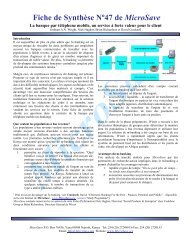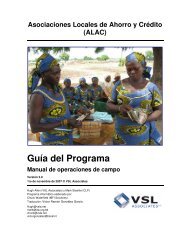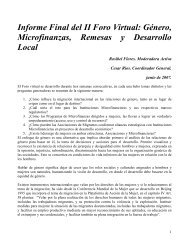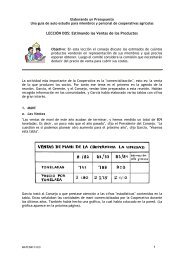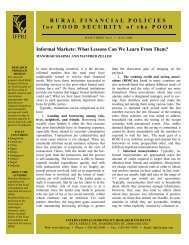review of warehouse receipt system and inventory credit initiatives in ...
review of warehouse receipt system and inventory credit initiatives in ...
review of warehouse receipt system and inventory credit initiatives in ...
Create successful ePaper yourself
Turn your PDF publications into a flip-book with our unique Google optimized e-Paper software.
CHAPTER 5: ALTERNATIVE APPROACHES FOR AFRICA<br />
Introduction<br />
Based on <strong>in</strong>ternational practice <strong>and</strong> experience <strong>in</strong> the six countries <strong>of</strong> Eastern <strong>and</strong> Southern<br />
Africa <strong>review</strong>ed here, one can categorise the follow<strong>in</strong>g ma<strong>in</strong> approaches to commodity<br />
f<strong>in</strong>anc<strong>in</strong>g <strong>and</strong> storage. Notwithst<strong>and</strong><strong>in</strong>g some overlap, this typology should help the reader to<br />
better underst<strong>and</strong> the alternatives.<br />
There are three major categories: 1. public warehous<strong>in</strong>g, 2. private warehous<strong>in</strong>g, <strong>and</strong> 3.<br />
farmer-focused approaches. The first <strong>and</strong> third categories (public <strong>and</strong> farmer-focused<br />
approaches), are further subdivided, mak<strong>in</strong>g a total <strong>of</strong> eight different approaches, as follows:<br />
Category 1: ‘Public warehous<strong>in</strong>g’, This term does not imply public ownership, but refers to<br />
a company stor<strong>in</strong>g goods for public <strong>in</strong> general, on behalf <strong>of</strong> whosoever wishes to<br />
deposit <strong>in</strong> the <strong>warehouse</strong>, <strong>and</strong> issues to the respective depositors <strong>warehouse</strong> <strong>receipt</strong>s<br />
that can be used for trad<strong>in</strong>g purposes (as documents <strong>of</strong> title), or as collateral for<br />
rais<strong>in</strong>g f<strong>in</strong>ance. This is <strong>in</strong> turn divided <strong>in</strong>to:<br />
A. Unregulated <strong>in</strong>dependent <strong>warehouse</strong>s<br />
B. Warehouses regulated by the State<br />
C. Warehouse regulated by a trade body<br />
D. Bulk<strong>in</strong>g by private trade <strong>in</strong>termediaries<br />
Category 2: ‘Private warehous<strong>in</strong>g’, i.e. <strong>warehouse</strong>s which provide similar services to those<br />
<strong>in</strong> Category 1, but with no obligation to receive deposits from the public <strong>in</strong> general<br />
Category 3: Farmer-focused approaches, to f<strong>in</strong>ance the storage <strong>of</strong> food for consumption<br />
dur<strong>in</strong>g the lean season, <strong>and</strong> the bulk<strong>in</strong>g <strong>of</strong> surpluses to be marketed at a later date.<br />
This is divided <strong>in</strong>to:<br />
A. Cooperative approaches to warehous<strong>in</strong>g, supported by bank lend<strong>in</strong>g<br />
B. Micr<strong>of</strong><strong>in</strong>ance-l<strong>in</strong>ked approaches<br />
C. Technological improvements <strong>in</strong> rural storage<br />
We describe Categories 1 <strong>and</strong> 2 as ‘commercial approaches’ because they are carried out on<br />
a relatively large scale <strong>and</strong> can <strong>in</strong>volve many different k<strong>in</strong>ds <strong>of</strong> depositors, <strong>and</strong> contrast them<br />
with Category 3, where farmers are the only (or near-only) depositors. In the follow<strong>in</strong>g<br />
subsections, we describe these approaches <strong>and</strong> discuss their advantages <strong>and</strong> disadvantages.<br />
This is also summarized at the end <strong>in</strong> Table 1 at the end <strong>of</strong> this Chapter.<br />
Approach 1.A: Public warehous<strong>in</strong>g by <strong>in</strong>dependent unregulated<br />
<strong>warehouse</strong> operators<br />
These build on the experience <strong>of</strong> countries with more highly developed market<strong>in</strong>g <strong>system</strong>s,<br />
notably <strong>in</strong> North America <strong>and</strong> South Africa. A trad<strong>in</strong>g company concerned sets up bus<strong>in</strong>ess<br />
<strong>in</strong> the country concerned, <strong>in</strong>vests <strong>in</strong> gra<strong>in</strong> h<strong>and</strong>l<strong>in</strong>g <strong>and</strong> storage plant, <strong>and</strong> uses it to trade <strong>and</strong><br />
provide a variety <strong>of</strong> other services, <strong>in</strong>clud<strong>in</strong>g storage <strong>and</strong> <strong>warehouse</strong> <strong>receipt</strong><strong>in</strong>g. In pr<strong>in</strong>ciple<br />
36




